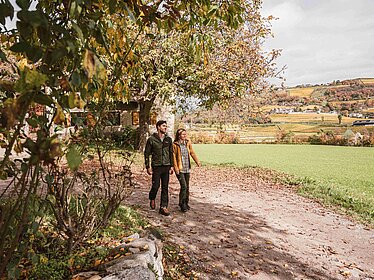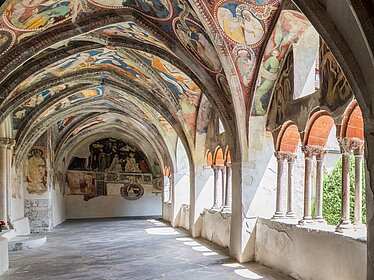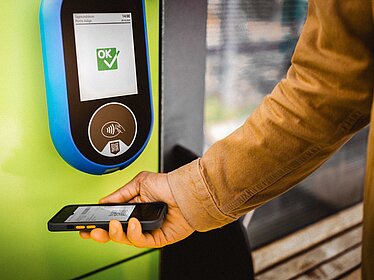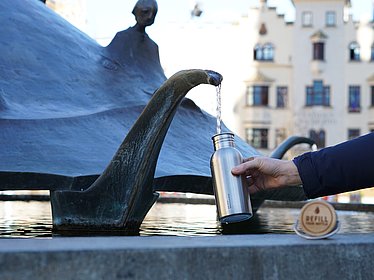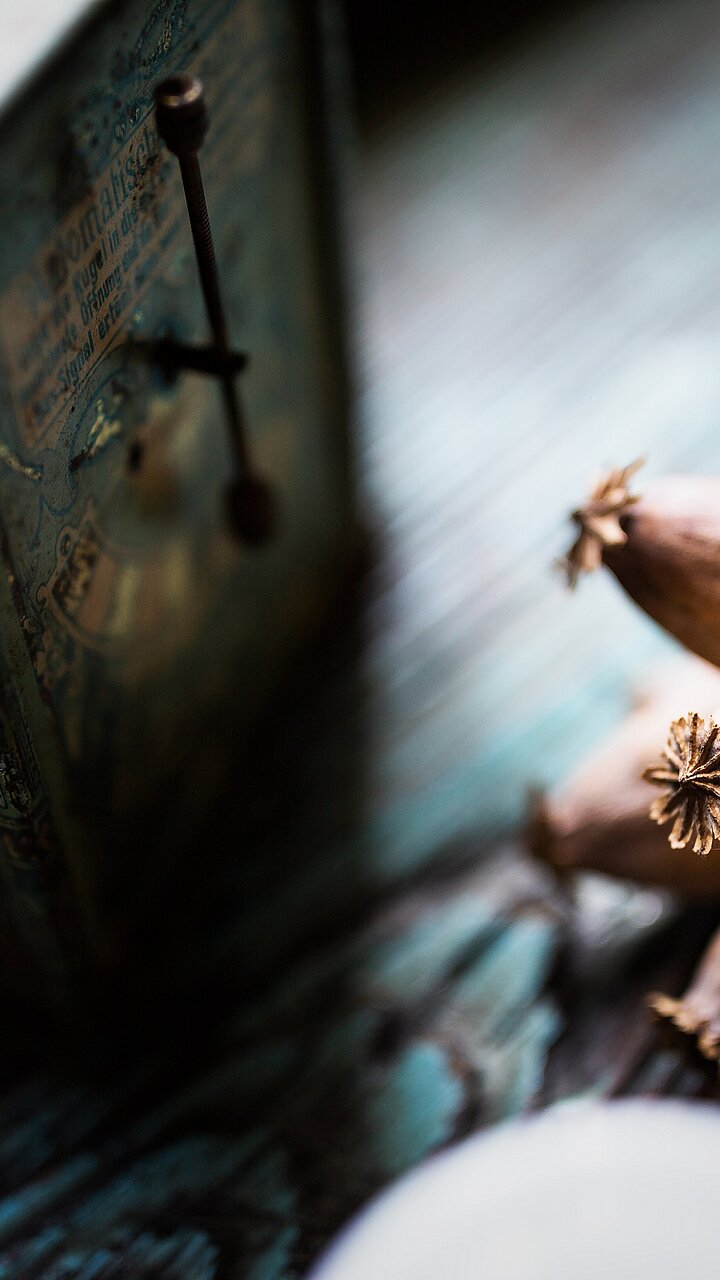Authentic stories
from Brixen and South Tyrol
The heart. The mountain air makes it beat faster and beautiful artworks seit it aflutter. And when the two come together, it’s enough to make it leap with joy. This is what we call pure happiness!
We take you on a journey and show you exactly what makes us stand out: their perfect blend of stunning nature and superb culture.
Happy reading!
Life in the Fast Lane
We hit the slopes with Linda Stricker to talk about how she is keeping her legendary husband’s legacy alive, skiing past and present, bizarre inventions, happy memories, cruel twists of fate and skiing with a baby bump
8 minutes
The snow on the sun-drenched Plose mountain is glistening under a cloudless sky as Linda Stricker bursts into view. “I always look forward to meetings like this,” she says radiantly. “They’re a great excuse to go skiing again.” She knows the Plose like the back of her hand. Her late husband, South Tyrolean ski legend Erwin Stricker, got his career off to a flying start here when he won the famous Stadtlrennen race in his youth. “I take it easy these days,” says Linda, a former ski racer herself. And then, of course, she sets off, as elegantly as ever and so quickly that it proves hard to keep up. We begin our chat as we ascend the mountain in the ski lift, the majestic Dolomites in full view, and continue it over a lunch of juicy ribs in the Pfannspitzhütte lodge. As we talk, it’s hard to imagine a more beautiful or fitting setting.

I was born in Amsterdam, the third of four children. Our father was a pilot and was crazy about sport – tennis, rowing and especially hockey. He played for the Dutch national hockey team 62 times and competed in two Olympics, winning silver and bronze. He was around 30 when he discovered skiing, and it soon became a shared family pursuit. At least once a year, we drove the 900 kilometres from Amsterdam to Gargellen in Vorarlberg, Austria – all crammed into our VW Beetle, the older children on the back bench and the younger ones in the boot. Later, when my father flew for Swissair, we moved to Lake Zurich. That was when I really caught the skiing bug. At some point, the ski instructor in Gargellen noticed that I wasn’t completely hopeless and let me train with the local children. Before long, I was competing in races and won the Dutch youth championships. And then, eventually, I took part in the Lowland Championships...
The what…?
The Lowland Championships! We Dutch skiers were up against the Belgians, Brits and Danes. I won and shortly afterwards competed in the Europa Cup and World Cup.

That’s hardly worth mentioning! At the World Championships in St. Moritz in 1974, I came 11th in the combined event and 20th in the slalom. And I was voted most beautiful skier at the tournament! I wasn’t a star, but it was an unforgettable time of my life.
Why?
Back then, the true star skiers attracted attention far beyond the skiing circuit. The world stood still when they took to the slopes. People held their breath as they listened to the races unfold on the radio or stood glued to TV screens in electrical stores. Fans went crazy, just like they did for the big boy bands of the day. Or the 1990s supermodels like Naomi Campbell or Claudia Schiffer. Things are very different today. If you asked the average person on the street what models or skiers they knew, they’d probably only be able to name one or two at most. Back then, skiers were real personalities. Today, they’re all heavily guarded. Everything is highly regimented and teams are shielded from the world. Nobody gets a look in anymore.
Erwin Stricker was one of those stars and a daredevil. Together with the likes of Piero Gros and Gustav Thöni, he was part of the legendary Italian team known as the “Valanga Azzurra” or “Blue Avalanche”. How did you meet?
It was at a Europa Cup final in Mayrhofen in Austria. I happened to be staying in the same hotel as the Italian men’s team. I still remember it so clearly. I was sitting on a swing in the park when he came up to me with his blonde curly hair and said, “I’m going to marry you!” I was gobsmacked. I thought he was crazy! But three years later, we were standing at the altar.

Pros from the women’s and men’s teams rarely got to mix during the season. While one team was training in Austria, the other would be in the USA. Did you have to spend a lot of time apart?
Oh no, we were joined at the hip. Erwin made sure of it. He was a wily fox and arranged for me to train with the Italian men’s team.
He took his ski racer girlfriend to training? Surely that was against the rules?
Of course it was. But he concocted a story based around the fact that my grandfather was from Suriname and my grandmother from Indonesia. He told the people in charge that we were already married. When the race director asked to see our marriage certificate, he explained that our wedding took place in accordance with a South American-Southeast Asian custom and there was no certificate. It was hilarious! The team soon welcomed me with open arms.
When did you stop racing?
The World Championships in Garmisch-Partenkirchen in 1978. I was already pregnant so our son, Tim, raced with me! I have to admit that I skied rather more gingerly than usual.

Yes, but only for another year. He was already working for Ellesse – the leading sports brand at the time – and his focus lay more with that than with racing. He was bursting with ideas about what he wanted to do next. Plus, he was picking up so many injuries that I was spending more time with him in hospital than watching him on the slopes. He was fearless – both on and off the slopes – and had broken virtually every bone in his body. I quickly learnt that with Erwin it was best to keep calm whatever the situation. One time he rang me in the middle of the night after overturning his jeep. As soon as he said “Linda, I’ve...”, I didn’t need to hear anything else and just asked him which hospital I had to go to.
how did you find us South Tyroleans at first?
Let me be frank. As a seafaring nation, the Netherlands is full of liberal-minded people who love to explore the world. The South Tyroleans are more conservative, having hidden behind their mountains for generations. It took me a while to learn to appreciate their qualities – their shy yet genuine willingness to help and their sincerity. Plus, South Tyrol has changed a lot and become much more open over the last few decades. I love living here these days.

Sometimes. For instance, he always said that, as his wife, I didn’t have to work. But I wanted to! There was no way I could just sit around the playground with other mothers chatting about nappies. One of my friends ran a pub and gave me a job waitressing. But that didn’t suit my jealous, headstrong husband at all. It was like a slap in the face for him, and meant he spent every evening sat at the bar, drinking a beer and brooding over his next move. Then one day, he suggested I take over his position as Ellesse’s sales representative for South Tyrol. He, meanwhile, turned his attention to launching the Rent and Go quality ski rental group.
Did the two of you have anything in common or were you complete opposites?
He was such a force of nature and could easily inspire people and rally them around him. I think I’ve inherited more of my grandmother’s Asian values, as I’m far more calm and collected. In that respect, we were chalk and cheese. It meant we fought a lot, but we always made up with each other very quickly again. Funnily enough, Erwin and my grandmother hit it off straightaway…
Tell me more!
I can still remember it like it was yesterday. We’d gone to Amsterdam so they could meet. When she greeted him at the top of the steep stairs so characteristic of Dutch houses, she pinched his upper arm and said, “Are you rich?” And then, after he had stood there in stunned silence for a few seconds, she added, “It doesn’t matter, but it would be nice.” From then on, they talked on the phone constantly. She taught him Dutch and he taught her the South Tyrolean dialect.

Yes, his mind never stopped whirring. He used to love sticking his hand out of the car window and watching in fascination at how it cut through the air when he held it out flat.
He invented the curved ski pole and was one of the first people to use a snow gun...
That’s right. He always trained in Vintl/Vandoies, where there was a small ski lift up to a short, but perfect slope. It had no direct sunlight, so when there was no natural snow on the ground, it was the ideal location for artificial snow. He ordered a machine from a company called Linde and became the first to use a snow gun on South Tyrolean soil. Everyone said, “That’s it, he’s finally gone mad!” But he could train while everyone else sat around hoping for snowy weather.
What else did he invent?
His vulture beak ski tips! He always took the most aggressive, tightest lines possible so would often straddle a gate. He came up with this idea to bend the tips of his skis by a few centimetres so he could get a few centimetres closer to the gate. He also invented the knee pads fitted into ski trousers. And the legendary plastic suits. What a sight they were! Word soon spread that they were the reason the Italians could ski so much faster standing upright than the Austrians could in a crouching position. But the suits were soon banned for being too dangerous. Undeterred, Erwin kept tinkering and soon designed a leather racing suit for both of us. Another of his inventions was an aerodynamic helmet, which almost saw him suffer the same fate as my father and break his neck.
Your father?
Yes, my father fell to his death skiing in deep snow. He crashed head first into an avalanche barrier hidden under the snow. He was just 60 years old.
That’s terrible. Your husband also passed away at 60.
Yes, they were both far too young.

At first, I was angry. Livid, in fact. At him! I said, “You can’t leave me! Not yet!” He died as he lived – with a bang. He first felt unwell when he was in China helping to set up a ski resort. On returning, he went straight to meet the South Tyrolean governor to discuss another project, and it was only after that that he was finally diagnosed with a brain tumour.
What happened next?
He had two operations, but when I saw him lying in hospital after that, I knew it was over. He’d always naturally been as strong as an ox and never had to do any strength training. He practically brought people to their knees when giving them a friendly handshake! But now he was a shadow of his former self.
What did you do next?
I quickly decided to jump in at the deep end and take over his businesses. I couldn’t exactly leave his employees in the lurch. We’ve expanded over the past ten years. Rent and Go now has 70 franchises across Italy, while Sportservice Erwin Stricker runs 7 ski rental shops, 12 bike rental shops and 3 sports shops in South Tyrol.
We’re sitting in a gondola on our way to the top of the Crazy Horse black run, which is named in honour of your husband. What does this place mean to you?
I love this descent. It’s a metaphor for our life together – steep, fast, and full of twists and turns. I think of him whenever I ski down it.
Erwin Stricker, born in 1950, was a ski racer and part of the Italian national team. He skied all disciplines, was a World Cup participant and took part in the 1972 Olympic Games in Sapporo and 1976 in Innsbruck, he was Italian champion twice, and he stood on the podium twice in the Ski World Cup. He was one of the wildest of the wild generation of the "Valanga Azzurra" around Piero Gros and Gustav Thöni. In 1979 he ended his career and became an entrepreneur and consultant in the winter sports sector. Even during his active time he contributed to numerous innovations in winter sports and winter tourism, but also in the bicycle sector. but also in the bicycle sector. Most recently, he was involved in the construction of a Chinese ski resort. He died on 28 September 2010 in the hospital in Bolzano as a result of a brain tumour.
Linda Stricker, born Esser, was born in the Netherlands in 1953, she spent some time of her childhood in the Caribbean and in Zurich, early on she found skiing in the Alps - and became a World Cup skier and World Cup participant. In 1977 she married Erwin Stricker. Today she lives in South Tyrol and, since the death of her husband, has been running the Since the death of her husband, she has managed Rent and Go, a company with 70 ski rentals throughout Italy, and Sportservice Erwin Stricker, a company with seven rentals, twelve bicycle stations and three sports shops in South Tyrol.



